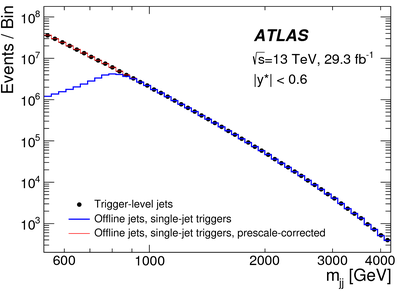What is the trigger and why is it important?
When the LHC operates, on average, about one billion proton-proton collisions per second happen at the ATLAS experiment. Our computing infrastructure is not able to either process or even store this amount of data - the volume would amount to over 100 petabytes per hour.
Luckily, the vast majority of collision events correspond to physics that we already know extremely well and that has been studied in detail before; we are only interested in rare events from which we can obtain new knowledge about nature. As we need to study only specific signatures, the ATLAS collaboration implemented specific hardware that can, within a few microseconds, decide if a collision contained something interesting. That data is then transferred to a computing farm where software algorithms check if the events contain the specific signatures we are interested in (within several milliseconds). This two-tier system is what we call a trigger. It reduces the amount of data we store to about one thousand events per second, which is less than 0.01% of the provided collisions.
Evolution of the trigger - why does it need to be constantly updated?
The LHC scientists and engineers are tirelessly working on improving the accelerator. Over the years they have increased the daily amount of data provided to ATLAS and other experiments at the LHC. In 2026-2028, the machine will be upgraded to provide ten-fold the amount of data of today.
In order to cope with this larger expected data volume, the trigger needs to be adjusted using both new hardware and software. New algorithms need to be implemented that better reconstruct the objects observed in the data in an extremely fast way.
Our group has a lot of experience in the trigger operation and, for example, has helped in porting the latest b-jet identification algorithm, based on machine-learning techniques, into the trigger, and by doing so improving the b-jet trigger performance.
New ideas - trigger-level analyses

A new idea our group is exploring is “trigger-level analyses”. This type of analyses does not use the full information ATLAS can extract out of a collision event, but only the reduced information the trigger is using to decide if an event will be saved. As the amount of information is greatly reduced, more events can be stored.
The plot here shows how much data (in this example, jet pairs) the ATLAS experiment can store with full event information (blue curve). At low jet-pair mass, there are so many events that the saved amount of data needs to be reduced (that is the trigger decided to not store all events). However, if one keeps only reduced trigger information (such as only the kinematics of the dijet pair), more events can be stored at low jet-pair mass (black dots).
The limitation thus is if the trigger information is sufficient to analyze the data to gain new insights into nature.
Our group has contributed to implementing a trigger-level event selection on b-jets and plans to investigate how much knowledge we can gain by performing a trigger-level analysis to search for the presence of Higgs pairs at low energies.
